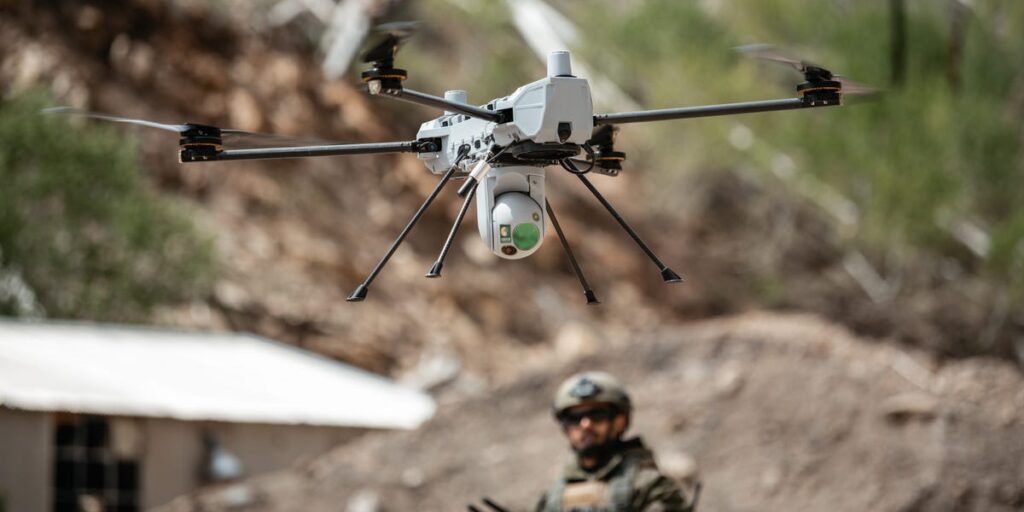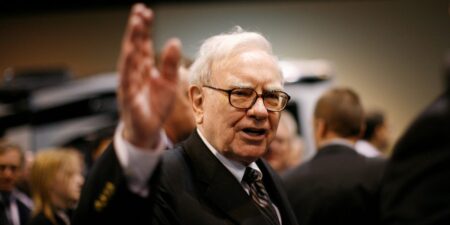More and more American drone companies are sprouting up as the tech takes over civilian and military sectors in a big way.
The Ukraine war has been an eye-opener about what drones can do in battle, and the Pentagon is leaning hard into the technology, as a planned Army overhaul shows.
With increased demand comes new companies eager to become suppliers. But Performance Drone Works, or PDW, wasn’t born from a sudden interest in uncrewed warfare. Instead, it came from the colorful quadcopters and flight courses of the televised Drone Racing League, where talented pilots would fly drones through complex obstacle courses at speeds up to 90 mph.
From drone racing to battlefield tech
PDW is an offshoot of the famed international racing league. The company set out six years ago to address the lack of US suppliers developing cutting-edge robotics, Ryan Gury, the company’s CEO and co-founder, told Business Insider. All of the drones flown by the league’s pilots are the same and made by DRL, and that is where Gury came in: drone design.
Now PDW is making drones for the military.
The priority is to make drones, like their flagship C100, and other technologies, “that are small and tactical and to be deployed by single units,” Gury said. “That’s our thesis.”
The C100 is a lightweight quadcopter that’s designed to fit in a rucksack and can fly over 70 minutes, up to 40mph, with a 10-pound payload. The latter can be adjusted based on mission requirements. PDW is also planning to debut a new, smaller, first-person-view drone this summer. The company announced over $15 million in C100 contracts and sales to the US Army in December.
For many years, combat drones were large, fixed-wing aircraft costing millions, but there’s a growing interest in small, inexpensive uncrewed aerial systems that can be employed down to the squad level, that warfighters could carry on their person, even in their pockets. The Ukraine war has shown that small UAS platforms can do battlefield surveillance, strike missions, bombing runs, and more.
Key to advancing that aim and fielding drones en masse are affordable systems at scale, close and flexible relationships with the Department of Defense, and a reliable domestic supply chain that is not dependent on foreign components.
A booming business
PDW is based in Huntsville, Alabama, where the rate of production on C100s has exceeded expectations. They’ve outgrown the factory they thought would last a few years in just eight or nine months.
“A year ago, at our board, we were mulling, ‘Can we produce 30 a month?'” retired Gen. Tony Thomas of US Special Operations Command, now chairman of the PDW Board, said. Now the company is making 70 a month, and soon, it’ll double that. For their upcoming FPV product, Gury said he expects numbers exceeding the present production figures.
Testing occurs throughout PDW’s drone-making process, Dylan Hamm, PDW’s chief technology officer who built small drones while serving as a Navy SEAL, told BI. Testing involves everything from making sure the drone has the desired payload capacity to evaluating weather, temperature, altitude, terrain, and countermeasure conditions.
“We test our drones every day,” he said. “Whether it’s at the flight test facility qualifying that they meet our design targets or actually taking them out to field events.”
Drone-making requires flexibility given the rapidly evolving battlespace. There’s much being learned from the electronic warfare countermeasure systems and the quick pace of innovation occurring in Ukraine. “When you have these systems in these complex operating environments that are constantly changing, we have to be ready to adapt,” Hamm said.
Designing systems for new fights
PDW has US veterans across its workforce and leadership — 20% and 63%, respectively. In conversations with BI, PDW staff who had served talked about the role of the drone in combat, the need to work closely with individual warfighters on these systems, and the quickened pace of adaptation and evolution.
Veterans bring a unique perspective to defense companies, but on cutting-edge systems, they have to look beyond their own experiences.
“If we’re designing the system for the wars that Dylan and I fought a couple of years ago, we’re behind,” PDW’s Chief Revenue Officer Chuck McGraw, another former SEAL, told BI.
The kind of fighting that has been seen in Ukraine has shown that the future of war is going to be very different from past conflicts. Matt Higgins, one of PDW’s co-founders, said that “the fact that you can take a $1,000 drone and take out an $8 million tank is an asymmetrical advantage that the world will never unsee.”
Drones and other UAS like loitering munitions have changed the game. The question now isn’t what can these systems do but whether the US has the industrial capacity to keep up.
PDW’s C100 is engineered and manufactured entirely in the US and doesn’t contain any Chinese-made parts; the majority of the drone’s parts come from American companies. The US military can’t just grab DJI drones off the shelf, and that complicates procurement. Military leadership is eager to strengthen domestic industry for drones but also for other weapons, ammunition, and assets.
Gury and Thomas highlighted the growing number of new companies in the defense industry, specifically ones that are working on drones, artificial intelligence and autonomous capabilities, and other future warfare elements. Thomas said it’s a really frenzied environment, a time when there’s “a real animus” to move away from legacy systems that may not win the next war and really “get onto transformational capabilities.”
Read the full article here
















